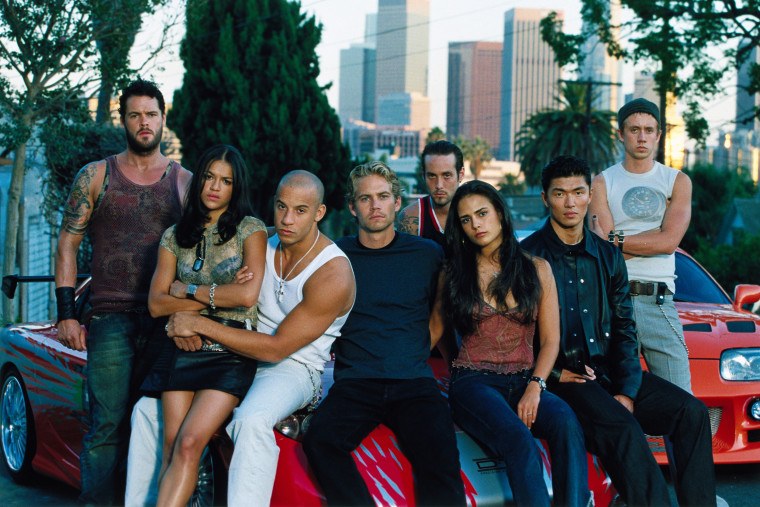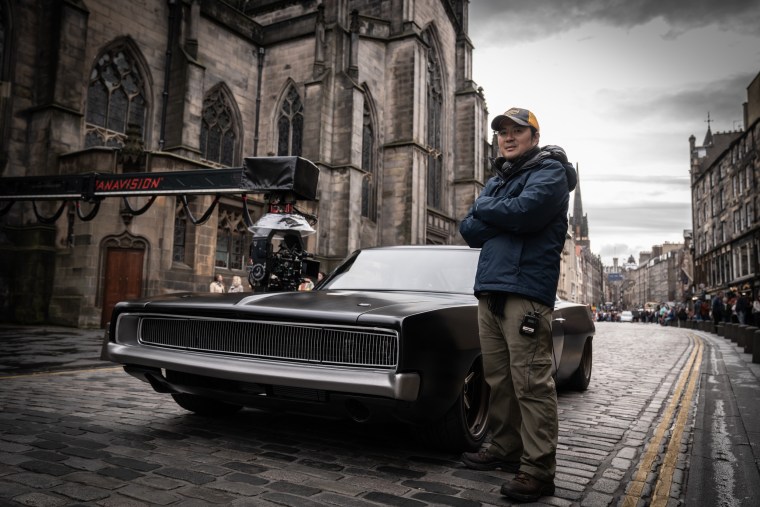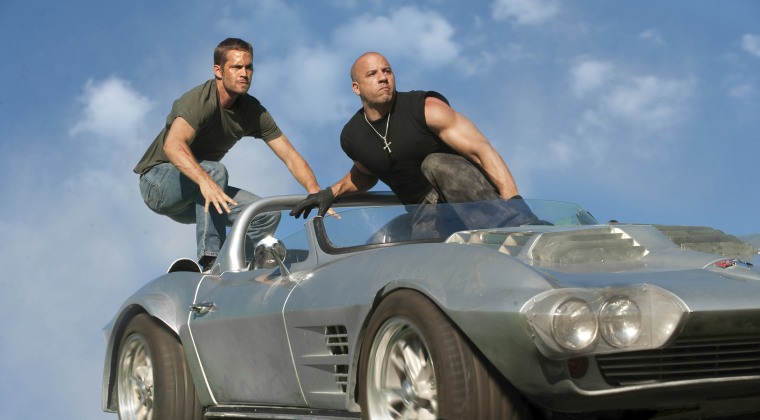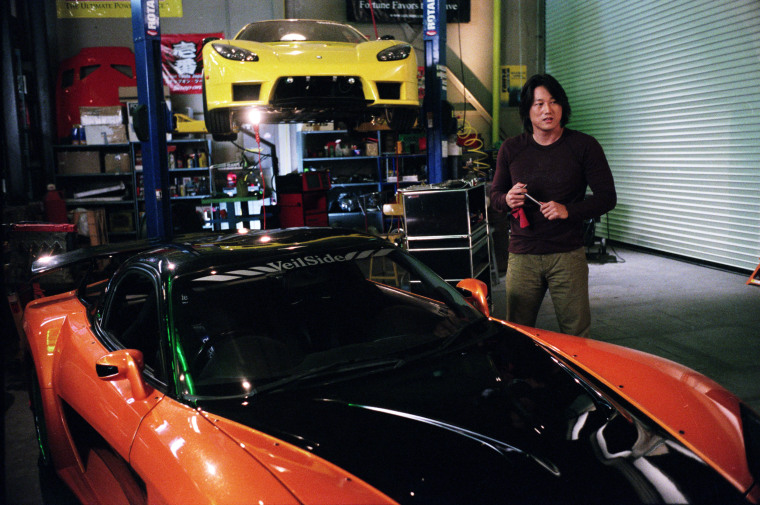During every premiere for a “Fast & Furious” movie, Vin Diesel and Paul Walker used to carve out time for their own private celebratory ritual.
The movies' two lead stars reminisced about how far they had come from the low-budget 2001 flick — about undercover cop Brian O'Connor (Walker), who infiltrates an illegal street racing crew led by the enigmatic Dominic Toretto (Diesel) — that developed into one of the unlikeliest box office successes in cinematic history.
“Everyone knew to always give us our space,” recalled Diesel of those moments with his late co-star. “And you’d hear the whole theater erupting and everybody wanted to say congratulations. But (for a moment) it would just be Paul and I.
“And he would always quietly say, ‘Vin, the best one is still in the can.’”
The assumption that an even better car chase, a bigger stunt or a deeper emotional arc still waits around the bend has kept the saga rolling through nine installments and one spinoff. Well, that and the $6.2 billion (and counting) the franchise has earned at the box office worldwide.
The latest, “F9,” hits theaters Friday. Directed by Justin Lin, his fifth lap with the franchise, the film once again puts Dom and his crew on a mission to save the world. Off screen, they may have to save the movie industry, too.
Originally scheduled to be released on May 22, 2020, “F9” was delayed during the Covid-19 pandemic. It now opens at a time when studios and movie exhibitors need to dig their way out of 15 months of economic devastation — first from quarantine closures, then from audiences’ reluctance to return to enclosed theaters.
"'F9' is going to be a foundational element in the recovery of movie theaters around the world," said Paul Dergarabedian, senior box office analyst for Comscore. "I don’t think we can overstate how important this film is for the industry."
This is the highest-profile movie released in the Covid-19 era: “Fast and Furious” ranks behind only Marvel, "Star Wars," "James Bond" and "Harry Potter" in box office among franchises.
Somehow the franchise has managed that feat even as it shifted gears from compact car movies to globe-spanning espionage missions, after the fourth one, and rewritten its mythology from film to film.
But the journey hasn’t always been smooth.
"Fast & Furious" continued even after the death of Walker in a fiery car crash during a break in filming "Furious 7" in 2013 — keeping his character, Brian, in the movie by enlisting the actor's brothers as stand-ins.
The saga has defied the industry's conventional wisdom off screen with as much abandon as it has ignored the laws of physics on screen. With a diverse cast that includes Michelle Rodriguez, Tyrese Gibson, Chris “Ludacris” Bridges, Nathalie Emmanuel and Sung Kang, "Fast & Furious" flouts the traditional Hollywood perception that actors of color can't carry a movie in international markets. Though filmmakers did damage some goodwill by killing off the lone major Asian hero, Kang's Han, three times on screen.
"Hollywood over the last 100 years has had its share of blatant racism and convinced itself that movies may do well in the U.S., but once they travel abroad they just flatline and die," said Gibson, who has ridden shotgun as Roman since 2003's "2 Fast 2 Furious."
"But domestically and internationally, we’ve always had a very diverse and inclusive cast," added Gibson, who is Black. "I’ve never been any other complexion than this and I’ve been in ('Fast & Furious') now for 18 years and having families overseas who don’t speak a lick of English who know who I am? I never take it for granted."
The franchise has come a long way since it’s humble start — in a 1996 Honda Civic.
That was the car that then-24-year-old reporter Kenneth Li's father bought him for his new reporting job at the New York Daily News. Little did he know that the "gas-sipping" Japanese import was a ride of choice on the illegal street racing scene because it's easy to “tune,” or modify to go faster.
"I went to a Honda dealership and they basically yelled at me that I was going to void the warranty," Li said. "The assistant of the guy who yelled at me came over and slipped me a card, saying, 'Call my guy,' and it turned out to be some kind of dingy car-tuner in Staten Island, of all places. Basically he walked me through the physics of going fast — the hotter the burn, the faster the exhaust."
It was Li's introduction to an after-hours underground racing scene — where drivers in souped-up imports competed in mile-long races on the parkways of New York then speeded away from the scene before the police arrived — often with a boost of nitrous oxide. That would put him in the orbit of a Dominican racer named Rafael Estevez, who dominated his races with equal parts charisma, confidence and superior driving skills.
Estevez would be the basis for Diesel's character.
"There was this entire subculture that in all my years in New York I had never seen before," Li said, "and I knew I wanted to write about it."
The result was a now-iconic 1998 piece for Vibe magazine titled "Racer X," which introduced that subculture to the mainstream — and to producer Neal Moritz.
"I thought the idea of setting a movie in that scene would be a great start to a movie," said Moritz, who optioned the article with Universal, which would become the parent company of NBC News in a 2004 merger. "I thought the culture, the color, the cars, the different ethnicities of people involved was an interesting backdrop for a movie."
That story ended up moving the action to Los Angeles, replacing the reporter with an undercover police officer and borrowing liberally from "Point Break" and "West Side Story." With a low budget, reported by Variety to be $38 million, director Rob Cohen would need up-and-comers rather than marquee names.

The first actor cast was Walker, himself a car enthusiast who was fresh off a previous collaboration with Moritz and Cohen on the thriller "The Skulls." Rodriguez, having received critical acclaim for her starring role in the indie drama "Girlfight," was cast as Letty; soap opera veteran Jordana Brewster joined the cast as Mia, Dom’s sister and Brian’s love interest.
But Moritz and Cohen still needed an actor to play Dom.
"We offered Timothy Olyphant the role, and the studio said, 'If you can get Timothy Olyphant, your movie’s greenlit,'" Moritz said. "But he turned it down."
Plan B turned out to be a future A-lister. At the time of his casting, Diesel was on the rise, having generated buzz at the Sundance Film Festival for his directorial feature, “Strays,” and a memorable part in Steven Spielberg’s “Saving Private Ryan.”
“The Fast and the Furious” arrived in theaters 20 years ago as a surprise box office hit, earning $144.5 million domestically. That brought out the starter pistol for a sequel returning Walker’s Brian O’Connor on another undercover assignment. But by then Diesel’s star was ascending, and he detoured to start another franchise with Cohen, a Generation X spy thriller called “XXX.” Even without him, “2 Fast 2 Furious” in 2003 broke the $100 million mark again, guaranteeing yet another sequel.
With “The Fast and the Furious: Tokyo Drift” three years later, however, the franchise arrived at a crossroads as stunning as the footage of “drifting” — an emerging trend in street racing.
Diesel returned for a cameo near the end of the film to race the main character, played by Lucas Black, in honor of their mutual friend Han (who died for the first time earlier in the film).

This cameo set up Diesel to produce the next installment of the franchise.
“They said, ‘If you do this cameo in ‘Tokyo Drift,’ you can produce [the next movie] the way you always wanted,’ which is continuing the story in more of an episodic fashion,” Diesel said.
“And I remember I called Paul,” Diesel continued. “He said, ‘If you’re producing, I’m in’”
Rodriguez was a tougher sell as the script for “Fast & Furious,” the fourth installment that hit theaters in 2009, included Letty’s death. But Diesel assured her she'd return in a future film.
Lin and Diesel were tuning the whole engine under the hood. 2011’s “Fast Five,” which introduced Dwayne "The Rock" Johnson as a federal agent out to catch Dom’s crew, was a globe-trotting heist movie that climaxed with a chase sequence in Rio de Janeiro worthy of a "Bond" movie.
The movie crossed the $200 million mark domestically.

Sure enough, Rodriguez’s Letty returned in “Fast & Furious 6” in 2013, reports of her death apparently having been greatly exaggerated. At the end of the movie, however, Han dies in the car crash previously glimpsed in “Tokyo Drift,” the saga having closed a three-film loop.
The death would lead to a continuing online outrage — a #JusticeforHan movement — fanned by Shaw’s eventual reform and addition to the heroes’ side.
Kang said he was first bemused by the outrage, then shocked when a Los Angeles Times reporter, Jen Yamato, held a vigil for Han.
“Han represented something for her not only in terms of as a ‘Fast’ fan but also as an Asian American person,” Kang said. “I started taking it seriously then.”

The most devastating blow to the franchise, though, was not scripted.
During a break in filming “Furious 7,” the cast and crew were thrown into chaos by a car crash off the screen. On Nov. 30, 2013, Walker died in a wreck in Southern California when the Porsche Carrera GT driven by his business partner slammed into a tree and burst into flames.
The production was shut down for five months with serious doubts if it could — or should — continue.
“I didn’t want to come back to shooting because it was too painful,” Diesel said. “It was too heartbreaking. I didn’t feel like I’d be able to perform.”
Diesel said his condition for the rewrite that would be necessitated by Walker’s absence was to not fall on the trope of having his character die in the film and have his friends rally to avenge him. Instead, the goal was for Brian O’Connor to drive off into the sunset at the end, the happy ending his co-star didn’t get in real life.
By the eighth film, “The Fate of the Furious” in 2017, Brian would be retired from the espionage game, raising his son with Mia away from the action.
“F9” would be the second premiere in which Diesel didn’t get to hear his friend talk about the potential for the next film.
“His presence is felt all the time because his daughter, Meadow, is on set with us, his brothers are always on set with us,” Ludacris said.
Even without Walker, the wheels keep turning on the “Fast & Furious.” The cast keeps growing, with a pair of Oscar winners, Charlize Theron and Helen Mirren, now onboard. John Cena wrestled his way in as a figure from Dom’s past and an adversary in the present.
And when Lin returned behind the camera, Kang did so in front of it. The pair have been friends for years and brainstormed how Han could have survived his apparent demise.
“We go on walks and we talk about the magic 'what ifs', where the characters could go and if this was possible,” Kang said. “So we have grandiose ideas of where Han could go and what he should be doing in ‘Fast 12,’ ‘Fast 13’ and a spinoff here.”
“Fast 13”? Maybe. There are at least two more movies mapped out and plenty of road left.
As exciting as the increasingly big (and increasingly incredulous) chase scenes are — with “F9” breaking the final frontier by sending a car into space — viewers seem to really gravitate toward the slower scenes, too, the ones that showcase the love between the crew that Dom refers to as his “family” several times per film. Diesel said that can be seen in the barbecue celebrations at the Toretto household that end every movie, when the diversity of the characters is on display around the table.
“You can watch this movie from any country, from any religion and know that there is a seat at the Dom Toretto barbecue table for you,” Diesel said. “That you know. That you feel. So if you’re watching the movie from Africa, or from Asia, or from Europe or from South America, you feel included and represented.”